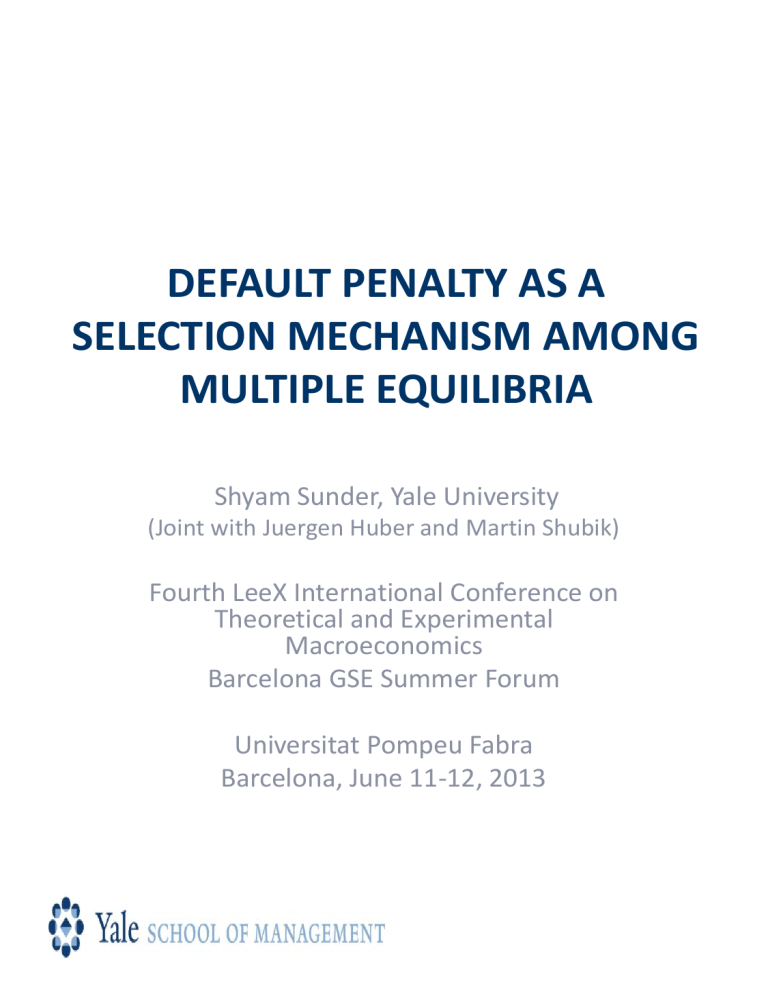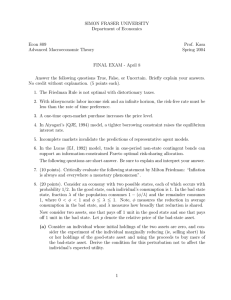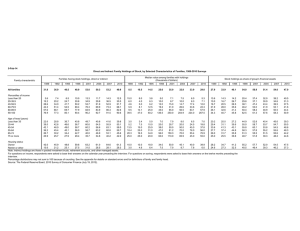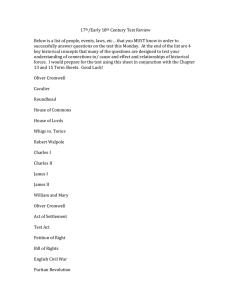Default Penalty as a Selection Mechanism Among Multiple Equilibria

DEFAULT PENALTY AS A
SELECTION MECHANISM AMONG
MULTIPLE EQUILIBRIA
Shyam Sunder, Yale University
(Joint with Juergen Huber and Martin Shubik)
Fourth LeeX International Conference on
Theoretical and Experimental
Macroeconomics
Barcelona GSE Summer Forum
Universitat Pompeu Fabra
Barcelona, June 11-12, 2013
A basic question and several solutions
• In the abstract general equilibrium theory of closed exchange and exchange-production economies, several equilibria may be present.
• Dynamic models of macro economy tend to ignore this possibility in spite of importance of reconciling theory and policy.
• Equilibrium selection has is a mathematical challenge
• Special solutions: existence of gross substitutability among all goods, or the presence of a good which appears as a linear separable term in all utility functions
• Perhaps enriching abstract models with politicoeconomic institutional features of the economy may be sufficient as first order approximations for equilibrium selection
• Candidates: combine fiat money with default and bankruptcy laws to create a synthetic commodity which appears as linear separable term in utilities
• Use a theoretically sufficient condition from institutional context to cut the Gordian knot of multiplicity of equilibria
2
A Summary of
Experimental Evidence
• Default penalties and bankruptcy laws are needed to implement general equilibrium as a playable game and to mitigate strategic defaults
• They can also provide conditions for uniqueness of equilibria
• Assignment of default penalty on fiat money economy goes to selected equilibrium
• Role of accounting/bankruptcy aspects of social mechanisms in resolving mathematically intractable multiplicity problem
3
• The work of Arrow, Debreu and
Mckenzie proved the existence of efficient prices but did nothing about their evolution or their fairness.
• This can be seen easily when we observe that an economy may have many equilibria.
6
• One of the tasks of extreme mathematical difficulty is what necessary and sufficient conditions are required for a unique competitive equilibrium to exist?
• We suggest that the society addresses both uniqueness and fairness through its socioeconomic institutions
7
• We could explore this possibility by extending the model to embed it an a dynamic model of society that permits default and requires default laws.
• To this end, our program involves both theory and experimentation.
• We utilize an example of an exchange economy with three equilibrium points constructed by
Shapley and Shubik 1977. This is illustrated in the next slide.
8
Figure 1: An Exchange Economy with
Two Goods and Three Competitive
Equilibria
9
• We observe that it has three equilibrium points the two extreme ones favoring either traders of type a or b.
• The middle is more equitable
(and is not stable under Walrasian dynamics)
10
• When this exchange economy is remodeled as a playable strategic market game permitting borrowing, default rules must be specified to take care of every possibility in the system.
• But these rules will entail some action of negative worth to the defaulter and are denominated in money. Thus they link money to the individual ’ s utility
11
• Technically if the penalties are set equal to or above the Lagrangian multipliers of the related general equilibrium model this will be sufficient to prevent strategic bankruptcy. Thus by selecting the penalties we can select the equilibrium point to be chosen.
12
• In selecting the penalties associated with the middle equilibrium the society can resolves its “ fairness ” problem; but from the viewpoint of finance it does not select the minimal cash flow equilibrium.
• This is shown in the next slide
13
Comparison of Prices in the
Three Competitive Equilibria
Trade
1
Trade
2
Final 1 Final 2 Price
1
Price
2
Trade
CE
1
CE
2
32.26
10.74
7.74,
10.74
13.17
19.82
26.83,
29.82
32.26,
39.26
13.17,
20.18
3.97
20.11
383.66
12.5
9.375
570.13
CE
3
3.21
39.77
36.97,
39.77
3.21,
10.23
19.5
3
5.47
475.66
14
• There is a considerable literature on multiple equilibria as is summarized by Morris and shin(2000)
• They deal primarily with Bayesian equilibria with noise
• Our approach here is different from, but complementary with, this literature. We stress the laws of society as providing direct strong coordinating and coercive devices for the economy
16
Experimental Design and
Results
Balances Carried
Forward Period to
Period (CO)
Endowments
Refreshed each
Period (RI)
Exchange of Goods without Money
T1a (A is numeraire),
T1b (B is numeraire)
Fail to converge to any CE
Exchange of Goods with Money and
Penalty Targeted at one of the CEs
Exchange of Goods with Money and non-CE Penalty
T2a,
T2b,
T2c
Converge to selected CE
T3
Converge to other outcomes determined by selected penalty
T2a-R,
T2b-R,
T2c-R
Converge to selected CE
T3-R
Converge to other outcomes determined by selected penalty
17
Treatment 1
• Two subject types with endowments of (40, 0) and (0, 50) of goods (A, B). No money.
• All subjects know their initial endowments and the earnings functions, and bid and offer some of their endowments for exchange.
U
1
( x , y )
= x
+
100(1
e
y /10
)
U
2
( x , y )
= y
+
110(1
e
x /10
)
• Benchmark treatment to check the convergence in presence in theoretical multiplicity.
18
Treatment 1: Conjectures
1. In Treatment 1 the process fails to converge to any of the three competitive equilibria.
2. In Treatment 1 the middle CE is favored.
3. In Treatment 1 the choice of the medium of exchange or numeraire does not influence the outcomes (prices and distribution of goods).
19
Figure 2: Holdings of Goods A and B in the Four Runs of Treatment 1a
(with Good A as the Numeraire)
50
Holdings of goods A and B in Run 1-1 of T1a
50
Holdings of goods A and B in Run 1-2 of T1a
40
40
30
30
20
20
30
20
10
40
10
0
0 10 20 holdings of good A
30
Holdings of goods A and B in Run 2-1 of T1a
50
40
0
0 10 20 holdings of good A
30
Holdings of goods A and B in Run 2-2 of T1a
50
40
40
30
20
10
0
0 10 20 holdings of good A
30 40
10
0
0 10 20 holdings of good A
30 40
20
Figure 3: Holdings of Goods A and B in the Four Runs of Treatment 1b
(with Good B as the Numeraire)
50
Holdings of goods A and B in Run 1-1 of T1b
50
Holdings of goods A and B in Run 1-2 of T1b
40 40
30
30
20
20
10
40
30
20
10
0
0
0
0 10 20 holdings of good A
30
Holdings of goods A and B in Run 2-1 of T1b
50
40
10
0
0 10 20 holdings of good A
30
Holdings of goods A and B in Run 2-2 of T1b
50
40
40
10 20 holdings of good A
30 40
30
20
10
0
0 10 20 holdings of good A
30 40
21
23
Treatment 1
• No clear convergence to any of the three CEs.
• It does not matter which of the two goods in this exchange economy is chosen as the numeraire.
• All runs approached the Pareto surface. Efficiency in all markets is high, demonstrating that such simple markets serve well as coordination mechanisms.
24
Treatment 2
• Introduce money in endowment and and penalty for default
U
1
( x , y , z )
= m
1 z
+ x
+
100(1
e
y /10
)
U
2
( x , y , z )
= m
2 z
+ y
+
110(1
e
x /10
)
• Set mu(1) 1 and mu(2) = 0.28,
0.75 and 5.07 respectively, in
Treatments 2a, 2b and 2c
(corresponding to the respective marginal values of income in the three equilibria)
• Runs without and with reinitialization of endowments
25
Treatment 2: Conjectures
• Subjects’ earnings functions were common knowledge and were provided to them algebraically as well as numerically
• First type of traders: Points earned = A + 100 * (1-e (-
B/10) ) + NET MONEY,
• Second type of traders: Points earned = (1/ μ
2
110 * (1-e (-A/10) )) + NET MONEY,
) * ((B +
•
•
•
• where μ
2
5.07 in c.
= 0.28 in sub-treatments a, 0.75 in b, and
4. In Treatment 2 the system converges and can be made to converge to any of the three equilibria guided by the selection of parameter μ (default penalty).
5. Carry-over and re-initialization do not make a difference
6. In Treatment 2 net money holdings will be equal to the equilibrium level of zero.
26
28
29
30
32
33
34
35
Treatment 2
• These results of T2 and T2-R broadly confirm the results from
T1—the introduction of a money allows convergence to the unique equilibrium that is defined by the value/default penalty associated with the money.
38
Treatment 3: Conjectures
• 6. In Treatment 3 the unique equilibrium defined by the default penalties μ1 and μ2 is approached.
39
40
41
42
Treatment 3
• The unique equilibrium defined by the chosen penalty is approached in Treatment 3.
45
New Runs (No results yet)
• First type of traders: Points earned = A + 100 * (1-e (-B/10) ) + min(NET MONEY),
• Second type of traders: Points earned = (1/ μ
2
) * ((B + 110 * (1e (-A/10) )) + min(NET MONEY),
• where μ
2
= 0.28 in sub-treatments a, 0.75 in b, and 5.07 in c.
46
Conclusions
• Attempt to explore the role of institutions
(e.g., bankruptcy laws, accounting) in resolving multiplicity problems in closed economies
• Treatment 1 as a benchmark: Empirical support for theoretical indeterminacy.
• Treatment 2: Salvage value/default penalty of a fiat money can be chosen to achieve any of the competitive equilibria of the original economy.
• Treatment 3 as robustness check: Other penalties generate specific equilibrium outcomes (but not necessarily economize on use of money)
• Next set of experiments: change
• Institutional arrangements in a society provide the means to resolve the possibility of multiple equilibria in an economy.
• Empirical support for the attitudes of macroeconomists who do not regard the non-uniqueness of competitive equilibria as a major applied problem.
47
Thank You.
Shyam.sunder@yale.edu
www.som.yale.edu/faculty/ research
Trading Screen without
Fiat Money
49
Results Screen without
Fiat Money
50
Payoff Tables
Table for those initially endowed with A: A + 100 * (1-e
(-B/10)
)
Units of good A you hold at the end of a period
Units of B you hold
Units of B you hold
0
0
0.0
5
5.0
10
10.0
15
15.0
20
20.0
25
25.0
30
30.0
35
35.0
40
40.0
45
45.0
50
50.0
5 39.3 44.3 49.3 54.3 59.3 64.3 69.3 74.3 79.3 84.3 89.3
10 63.2 68.2 73.2 78.2 83.2 88.2 93.2 98.2 103.2 108.2 113.2
15 77.7 82.7 87.7 92.7 97.7 102.7 107.7 112.7 117.7 122.7 127.7
20 86.5 91.5 96.5 101.5 106.5 111.5 116.5 121.5 126.5 131.5 136.5
25 91.8 96.8 101.8 106.8 111.8 116.8 121.8 126.8 131.8 136.8 141.8
30 95.0 100.0 105.0 110.0 115.0 120.0 125.0 130.0 135.0 140.0 145.0
35 97.0 102.0 107.0 112.0 117.0 122.0 127.0 132.0 137.0 142.0 147.0
40 98.2 103.2 108.2 113.2 118.2 123.2 128.2 133.2 138.2 143.2 148.2
45 98.9 103.9 108.9 113.9 118.9 123.9 128.9 133.9 138.9 143.9 148.9
50 99.3 104.3 109.3 114.3 119.3 124.3 129.3 134.3 139.3 144.3 149.3
Table for those initially endowed with B: B + 110 * (1-e
(-A/10)
)
Units of good A you hold at the end of a period
0 5 10 15 20 25 30 35 40 45 50
0
5
0.0 43.3 69.5 85.5 95.1 101.0 104.5 106.7 108.0 108.8 109.3
5.0 48.3 74.5 90.5 100.1 106.0 109.5 111.7 113.0 113.8 114.3
10 10.0 53.3 79.5 95.5 105.1 111.0 114.5 116.7 118.0 118.8 119.3
15 15.0 58.3 84.5 100.5 110.1 116.0 119.5 121.7 123.0 123.8 124.3
20 20.0 63.3 89.5 105.5 115.1 121.0 124.5 126.7 128.0 128.8 129.3
25 25.0 68.3 94.5 110.5 120.1 126.0 129.5 131.7 133.0 133.8 134.3
30 30.0 73.3 99.5 115.5 125.1 131.0 134.5 136.7 138.0 138.8 139.3
35 35.0 78.3 104.5 120.5 130.1 136.0 139.5 141.7 143.0 143.8 144.3
40 40.0 83.3 109.5 125.5 135.1 141.0 144.5 146.7 148.0 148.8 149.3
45 45.0 88.3 114.5 130.5 140.1 146.0 149.5 151.7 153.0 153.8 154.3
50 50.0 93.3 119.5 135.5 145.1 151.0 154.5 156.7 158.0 158.8 159.3
51
Trading Screen with Fiat
Money
52
Results Screen with Fiat
Money
53
Payoff Table with Fiat
Money (T2c)
Table for those initially endowed with A: (A + 100 * (1-e^
(-B/10)
)) + Net Money
Units of B you hold
Units of good A you hold at the end of a period
Units of B you hold
0
0 0.0
5 10 15 20 25 30 35 40 45 50
5.0 10.0 15.0 20.0 25.0 30.0 35.0 40.0 45.0 50.0
5 39.3 44.3 49.3 54.3 59.3 64.3 69.3 74.3 79.3 84.3 89.3
10 63.2 68.2 73.2 78.2 83.2 88.2 93.2 98.2 103.2 108.2 113.2
15 77.7 82.7 87.7 92.7 97.7 102.7 107.7 112.7 117.7 122.7 127.7
20 86.5 91.5 96.5 101.5 106.5 111.5 116.5 121.5 126.5 131.5 136.5
25 91.8 96.8 101.8 106.8 111.8 116.8 121.8 126.8 131.8 136.8 141.8
30 95.0 100.0 105.0 110.0 115.0 120.0 125.0 130.0 135.0 140.0 145.0
35 97.0 102.0 107.0 112.0 117.0 122.0 127.0 132.0 137.0 142.0 147.0
40 98.2 103.2 108.2 113.2 118.2 123.2 128.2 133.2 138.2 143.2 148.2
45 98.9 103.9 108.9 113.9 118.9 123.9 128.9 133.9 138.9 143.9 148.9
50 99.3 104.3 109.3 114.3 119.3 124.3 129.3 134.3 139.3 144.3 149.3
Table for those initially endowed with B : 1/5.07 * (B + 110 * (1-e^
(-A/10)
) + Net Money
Units of good A you hold at the end of a period
0
0 0.0
5
8.5
10
13.7
15
16.9
20
18.8
25
19.9
30
20.6
35
21.0
40
21.3
45
21.5
50
21.6
5 1.0 9.5 14.7 17.8 19.7 20.9 21.6 22.0 22.3 22.4 22.5
10 2.0 10.5 15.7 18.8 20.7 21.9 22.6 23.0 23.3 23.4 23.5
15 3.0 11.5 16.7 19.8 21.7 22.9 23.6 24.0 24.3 24.4 24.5
20 3.9 12.5 17.7 20.8 22.7 23.9 24.6 25.0 25.2 25.4 25.5
25 4.9 13.5 18.6 21.8 23.7 24.8 25.5 26.0 26.2 26.4 26.5
30 5.9 14.5 19.6 22.8 24.7 25.8 26.5 27.0 27.2 27.4 27.5
35 6.9 15.4 20.6 23.8 25.7 26.8 27.5 27.9 28.2 28.4 28.5
40 7.9 16.4 21.6 24.7 26.6 27.8 28.5 28.9 29.2 29.3 29.4
45 8.9 17.4 22.6 25.7 27.6 28.8 29.5 29.9 30.2 30.3 30.4
50 9.9 18.4 23.6 26.7 28.6 29.8 30.5 30.9 31.2 31.3 31.4
54




